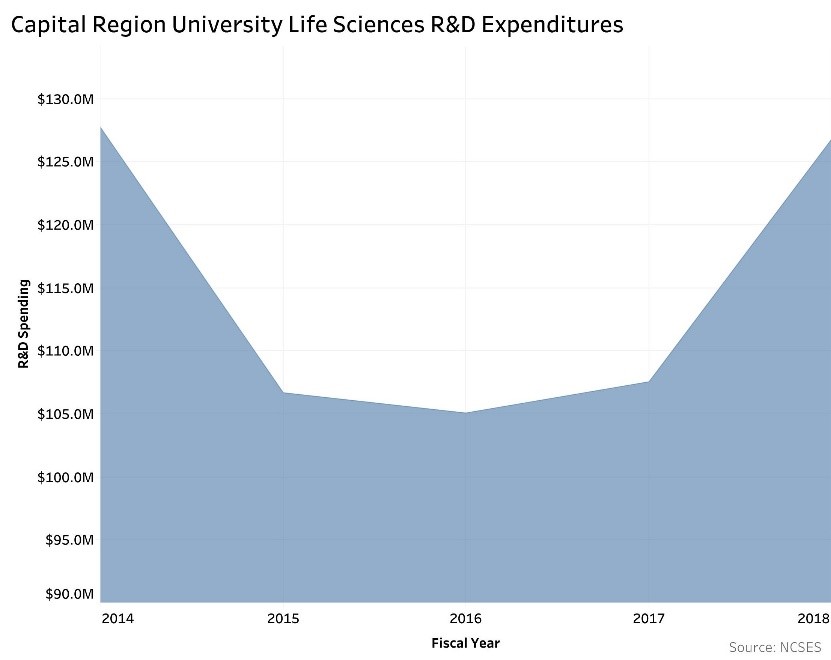Capital Region Academic Life Sciences R&D Surges
R&D spending on life sciences increased by nearly 18 percent to $126.7 million in fiscal 2018. That was a four-year high for local R&D spending in that field, according to a Center for Economic Growth (CEG) analysis of new data from the Nation Center for Science and Engineering Statistics.

The jump in life sciences R&D expenditures helped compensate for less spending in the field of engineering as several research projects winded down and new ones prepared for launch. In fiscal 2018, nine institutions in the region spent a total $550.6 million on R&D, down 6.3 percent from the previous fiscal year but close to fiscal 2016’s total spending level.
Life Sciences
In the life sciences, 55.3 percent of expenditures went toward health sciences R&D and 44.4 percent toward biological and biomedical sciences R&D.

Nearly three quarters (73.4 percent) of the life sciences R&D spending was attributable to the University at Albany. Over the year, the university’s R&D spending increased by 25.7 percent to $93.1 million. Out of the $19 million boost in life sciences R&D spending that UAlbany saw over the year, two thirds (66.9 percent) was attributable to increased federal funding. In fiscal 2018, UAlbany received its greatest amount of National Institutes of Health (NIH) funding in more than a decade.
Growth Trends
Fields that saw increases in R&D spending over the year included life sciences (17.8), non-science and engineering fields (16.3 percent), social sciences (14.9 percent), and computer and information sciences (5.5 percent).
Engineering R&D expenditures totaled $314.1 million, down 14.2 percent from the previous year. However, projects such as Applied Materials’ $850 Material Engineering Technology Accelerator (META) Center, which opened last month at SUNY Polytechnic Institute, will likely help drive more spending in this field. IBM’s plan to develop an AI Hardware Center at SUNY Poly will likely boost computer and information sciences R&D spending there as well.
CEG Activities
CEG and its Business Growth Solutions (BGS) unit leverage the Capital Region’s R&D assets to do the following:
Promote the region around the world at industry conferences;
Support the attraction to the region of biotech companies, such as PiSA BioPharm and ILÚM Health Solutions;
Improve startups’ access to labs at facilities, such as those at SUNY Poly and Albany Medical College’s Biomedical Acceleration and Commercialization Center (BACC);
Accelerate commercialization by leveraging tech scouting, gathering technology-driven market intelligence, engaging Empire State Development’s Division of Science, Technology and Innovation (NYSTAR) for testing and development;
Develop prototypes with its Stratasys F270 3D printer at the Tech Valley Center of Gravity or provide hand-on access to it;
Assist in the preparation of grant applications for the National Institutes of Health (NIH), Small Business Innovation Research (SBIR) program and Small Business Technology Transfer Program; and
Identify potential investors and providing venture pitch coaching through the VentureB series.
Don’t miss these insights into the trends that are shaping the Capital Region’s economy. Sign up for CEG’s e-news and follow us on:














